AMD Zen 2 Microarchitecture Analysis: Ryzen 3000 and EPYC Rome
by Dr. Ian Cutress on June 10, 2019 7:22 PM EST- Posted in
- CPUs
- AMD
- Ryzen
- EPYC
- Infinity Fabric
- PCIe 4.0
- Zen 2
- Rome
- Ryzen 3000
- Ryzen 3rd Gen
CCX Size
Moving down in node size brings up a number of challenges in the core and beyond. Even disregarding power and frequency, the ability to put structures into silicon and then integrate that silicon into the package, as well as providing power to the right parts of the silicon through the right connections becomes an exercise in itself. AMD gave us some insight into how 7nm changed some of its designs, as well as the packaging challenges therein.
A key metric given up by AMD relates to the core complex: four cores, the associated core structures, and then L2 and L3 caches. With 12nm and the Zen+ core, AMD stated that a single core complex was ~60 square millimeters, which separates into 44mm2 for the cores and 16mm2 for the 8MB of L3 per CCX. Add two of these 60mm2 complexes with a memory controller, PCIe lanes, four IF links, and other IO, and a Zen+ zeppelin die was 213 mm2 in total.
For Zen 2, a single chiplet is 74mm2, of which 31.3 mm2 is a core complex with 16 MB of L3. AMD did not breakdown this 31.3 number into cores and L3, but one might imagine that the L3 might be approaching 50% of that number. The reason the chiplet is so much smaller is that it doesn’t need memory controllers, it only has one IF link, and has no IO, because all of the platform requirements are on the IO die. This allows AMD to make the chiplets extremely compact. However if AMD intends to keep increasing the L3 cache, we might end up with most of the chip as L3.
Overall however, AMD has stated that the CCX (cores plus L3) has decreased in size by 47%. That is showing great scaling, especially if the +15% raw instruction throughput and increased frequency comes into play. Performance per mm2 is going to be a very exciting metric.
Packaging
With Matisse staying in the AM4 socket, and Rome in the EPYC socket, AMD stated that they had to make some bets on its packaging technology in order to maintain compatibility. Invariably some of these bets end up being tradeoffs for continual support, however AMD believes that the extra effort has been worth the continued compatibility.
One of the key points AMD spoke about with relation to packaging is how each of the silicon dies are attached to the package. In order to enable a pin-grid array desktop processor, the silicon has to be affixed to the processor in a BGA fashion. AMD stated that due to the 7nm process, the bump pitch (the distance between the solder balls on the silicon die and package) reduced from 150 microns on 12nm to 130 microns on 7nm. This doesn’t sound like much, however AMD stated that there are only two vendors in the world with technology sufficient to do this. The only alternative would be to have a bigger bit of silicon to support a larger bump pitch, ultimately leading to a lot of empty silicon (or a different design paradigm).
One of the ways in order to enable the tighter bump pitch is to adjust how the bumps are processed on the underside of the die. Normally a solder bump on a package is a blob/ball of lead-free solder, relying on the physics of surface tension and reflow to ensure it is consistent and regular. In order to enable the tighter bump pitches however, AMD had to move to a copper pillar solder bump topology.
In order to enable this feature, copper is epitaxially deposited within a mask in order to create a ‘stand’ on which the reflow solder sits. Due to the diameter of the pillar, less solder mask is needed and it creates a smaller solder radius. AMD also came across another issue, due to its dual die design inside Matisse: if the IO die uses standard solder bump masks, and the chiplets use copper pillars, there needs to be a level of height consistency for integrated heat spreaders. For the smaller copper pillars, this means managing the level of copper pillar growth.
AMD explained that it was actually easier to manage this connection implementation than it would be to build different height heatspreaders, as the stamping process used for heatspreaders would not enable such a low tolerance. AMD expects all of its 7nm designs in the future to use the copper pillar implementation.
Routing
Beyond just putting the silicon onto the organic substrate, that substrate has to manage connections between the die and externally to the die. AMD had to increase the number of substrate layers in the package to 12 for Matisse in order to handle the extra routing (no word on how many layers are required in Rome, perhaps 14). This also becomes somewhat complicated for single core chiplet and dual core chiplet processors, especially when testing the silicon before placing it onto the package.
From the diagram we can clearly see the IF links from the two chiplets going to the IO die, with the IO die also handling the memory controllers and what looks like power plane duties as well. There are no in-package links between the chiplets, in case anyone was still wondering: the chiplets have no way of direct communication – all communication between chiplets is handled through the IO die.
AMD stated that with this layout they also had to be mindful of how the processor was placed in the system, as well as cooling and memory layout. Also, when it comes to faster memory support, or the tighter tolerances of PCIe 4.0, all of this also needs to be taken into consideration as provide the optimal path for signaling without interference from other traces and other routing.


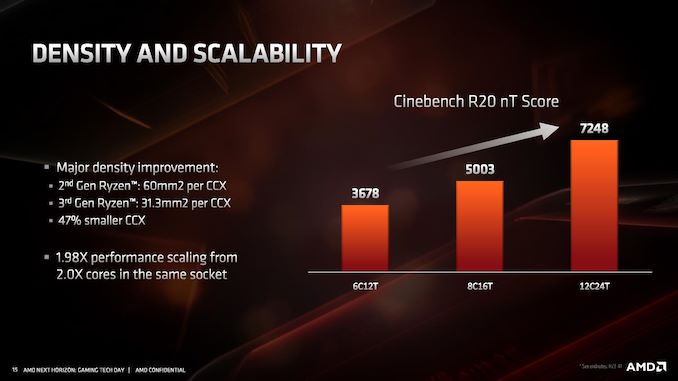
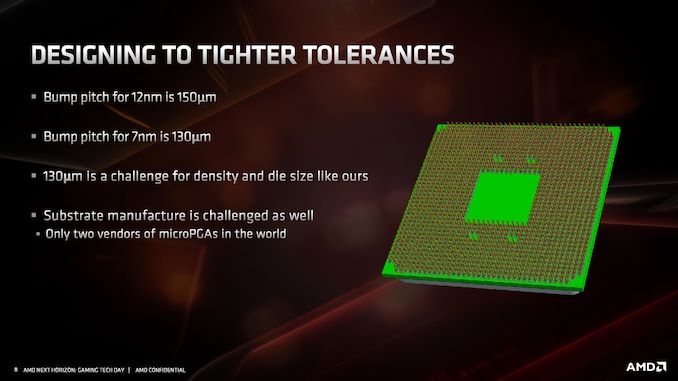
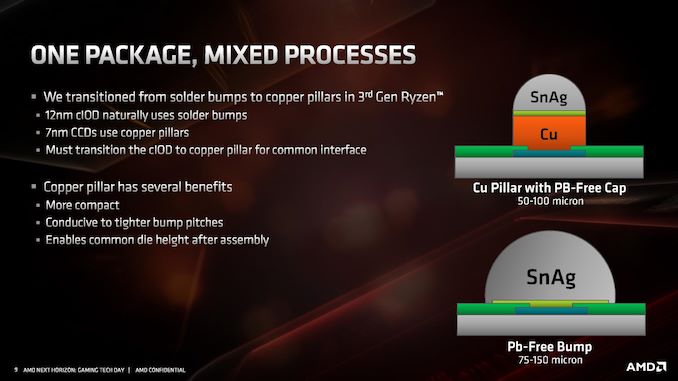
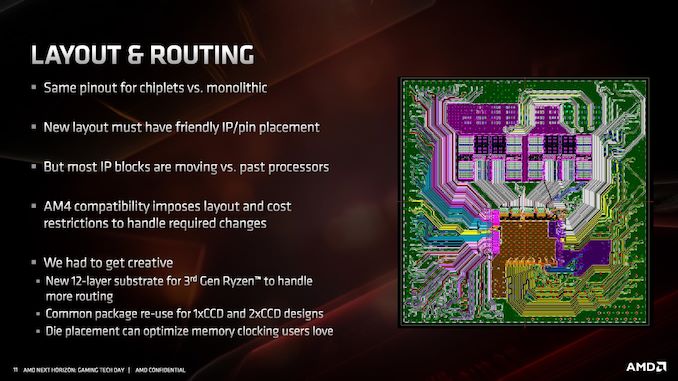
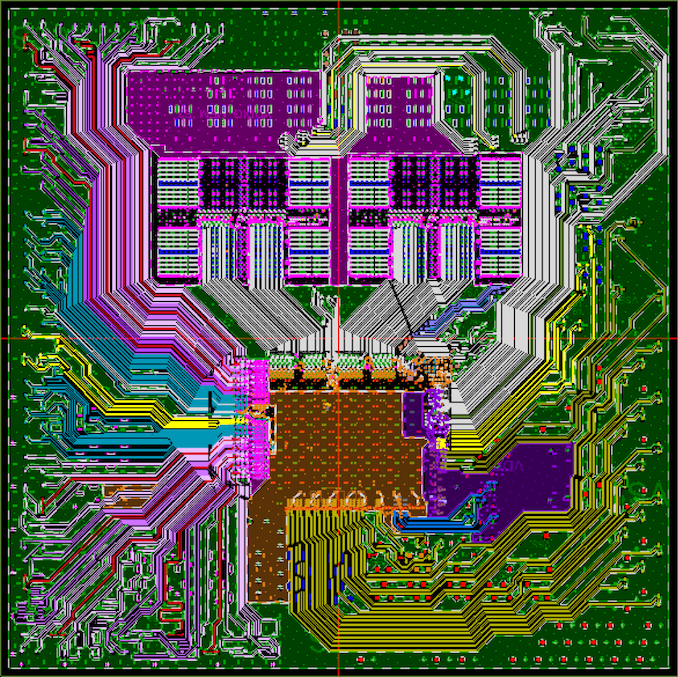








216 Comments
View All Comments
Kjella - Thursday, June 13, 2019 - link
The Ryzen 1800x got dropped $150 in MSRP nine months after launch, I think AMD thought octo-core might be a niche market they needed strong margins on but realized they'd make more money making it a mainstream part. I bought one at launch price and knew it probably wouldn't be great value but it was like good enough, let's support AMD by splurging on the top model. Very happy it's now paying off, even though I'm not in the market for a replacement yet.deltaFx2 - Tuesday, June 11, 2019 - link
@jjj: Rriigght... Moore's law applies to transistors. You are getting more transistors per sq. mm, and that translates to more cores. ST performance is an arbitrary metric you came up with. It's like expecting car power output (HP/W) go increase linearly every new model and it does not work that way. Physics. So, they innovate on other things like fuel economy, better drive quality, handling, safety features... it's life. We aren't in the 1980s anymore where you got 2x ST perf from a process shrink. Frequency scaling is long dead.The other thing you miss is that the economies of scale you talk about are dying. 7nm is *more* expensive per transistor than 28nm. Finfet, quad patterning, etc etc. So "TSMC gives them more perf per dollar" compared to what? 28nm? No way. 14nm? Nope.
RedGreenBlue - Tuesday, June 11, 2019 - link
Multi-threaded performance does have an effect on single threaded performance in a lot of use cases. If you can afford a 12 core cpu instead of an 8, you would end up with better performance in the following situation: You have one or two multithreaded workloads that will have the most throughput when maxing out 7 strong threads, you want to play a game or run one task that is single-threaded. That single-threaded task is now hindered by the OS and any random updates or processes running in the background.Point being, if you ever do something that maxes out (t - 1) cores, even if there's only one thread running on each, then suddenly your single threaded performance can suffer at the expense of a random OS or background process. So being able to afford more cores will improve single-thread performance in a multitasking environment, and yes multitasking like that is a reality today in the target market AMD is after. So get over it, because that's what a lot of people need. Nobody cares about you, it's the target market AMD and Intel care about.
FunBunny2 - Wednesday, June 12, 2019 - link
"You have one or two multithreaded workloads that will have the most throughput when maxing out 7 strong threads, you want to play a game or run one task that is single-threaded."the problem, as stated for years: 'they ain't all that many embarrassingly parallel user space problems'. IOW, unless you've got an app *expressly* compiled for parallel execution, you get nothing from multi-core/thread. what you do get is the ability to run multiple, independent programs. since we only have one set of hands and one set of eyes, humans don't integrate very well with OS/MFT. that's from the late 360 machines.
yankeeDDL - Thursday, June 13, 2019 - link
I am doing office work, and, according to Task Manager, there are ~3500 threads running on my laptop. Obviously, most threads are dormant, however, as soon as I start downloading something, while listening to music and editing an image, while the email client checks the email and the antivirus scans "everything", I will certainly have more than "10" threads active and running. Having more cores is nearly always beneficial, even for office use. I do swap often between a Core i7 5500 (2 cores, 4 threads) and a desktop with Ryzen 5 1600 (6C, 12T). It is an apples to oranges comparison, granted, but the smoothness of the desktop does not compare. The laptop chokes easily when it is downloading updates, the antivirus is scanning and I'm swapping between multiple applications (and it has 16GB of RAM - it was high end, 4 years back).2C4T is just not enough in a productivity environment, today. 4C8T is the baseline, but anyone looking to future-proof its purchase should aim for 6C12T or more. Intel's 9 gen is quite limited in that respect.
Ratman6161 - Friday, June 14, 2019 - link
Personally I would ignore anything to do with pricing at this point. The MSRP can be anything they want, but the street prices on AMD processors have traditionally been much lower. At ouor local Microcenter for example, 2700X can be had for $250 while the 2700 is only $180. On the new processors, if history is any indicator, prices will fall rapidly after release.mode_13h - Tuesday, June 11, 2019 - link
I think the launch prices won't hold, if that's your main gripe.I would like to be able to buy an 8-core that turbos as well as the 16-core, however. I hope they offer such a model, as their yields improve. I don't need 16 cores, but I do care about single-thread perf.
azazel1024 - Tuesday, June 11, 2019 - link
I have a financial drain right now, but once that gets resolved in (hopefully) a couple of months I think I am finally going to upgrade my desktop with Zen 2. Probably look at one of the 8-core variants. I am running an i5-3570 driven at 4Ghz right now.So the performance improvement should be pretty darned substantial. And I DO a lot of multithread heavy applications like Handbrake, Photoshop, lightroom and a couple of others. The last time I upgraded was from a Core 2 Duo E6750 to my current Ivy Bridge. That was around a 4 year upgrade (I got a Conroe after they were deprecated, but before official EOL and manufacturing ceasing) IIRC. Now we are talking something like 6-7 years from when I got my Ivy Bridge to a Zen 2 if I finally jump on one.
E6750 to i5-3570 represented about a 4x increase in performance multithreaded in 4 years (or ballpark). i5-3570 to 3800x would likely represent about a 3x improvement in multithreaded in 6-7 years.
I wonder if I can swing a 3900x when the time comes. That would be probably somewhat over 4x performance improvement (and knowing how cheap I am, probably get a 3700x).
Peter2k - Tuesday, June 11, 2019 - link
Yeah, but you have to say something negative about everythingbobhumplick - Tuesday, June 11, 2019 - link
i agree. i mean its an incredible cpu line. but just throwing all of that extra die space and power budget at just more cores and cahce. i mean look at the cache to core ratio. when cpu makers just throw more cache or cores at a node shrink it can be because that makes the most sense at the time(the market, workloads, or supporting tech like dram have to catch up to enaable more per core performance) but it can also mean they just didnt know what else to do with the space.maybe its just not possible to go much beyond the widths modern cpus are approaching. even intel is using a lot of space up for avx 512 which is similar to just adding more cores (more fpu crunchers ) so its possible that neither company knows how to balance all those intructions in flight or make use of more execution resources. maybe cores cant get much more performance.
but if so that means a prettyy boring future. especially if programmers cant find ways to use those cores in more common tasks